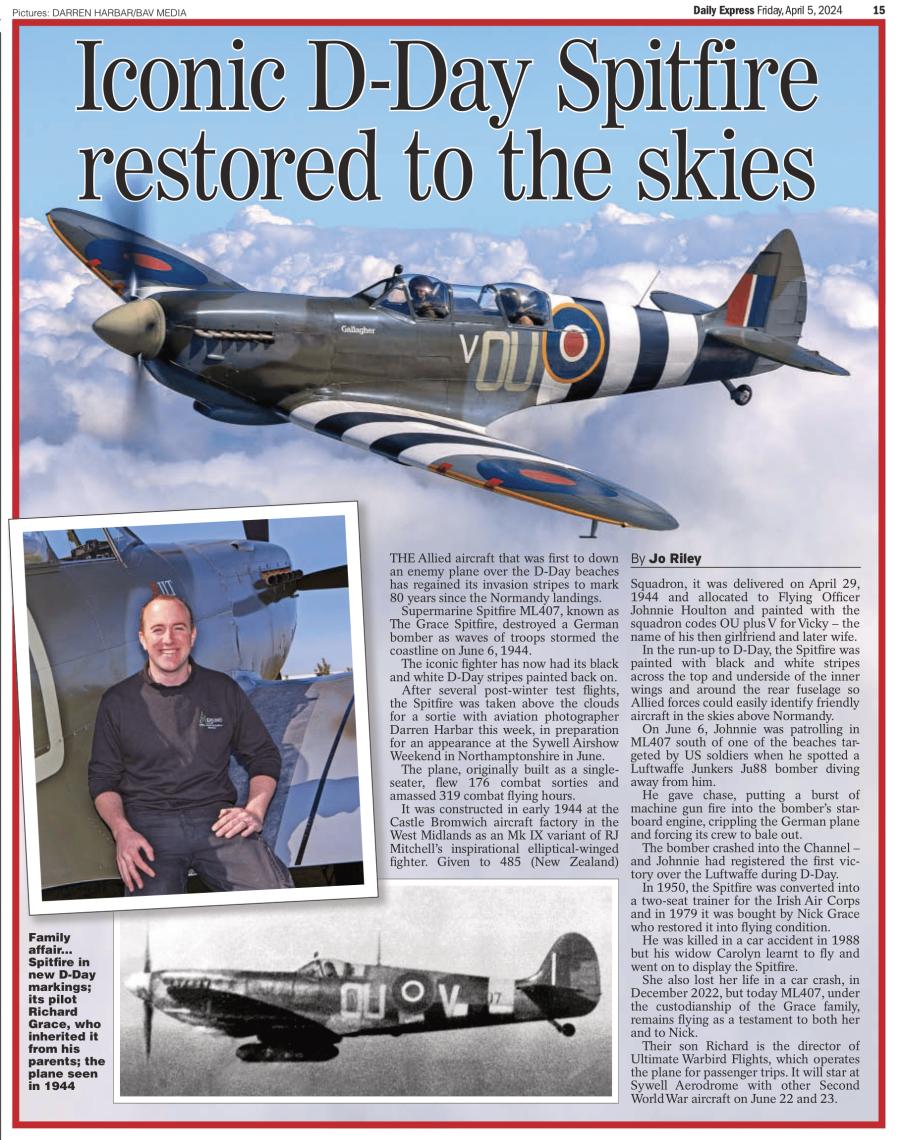Supermarine Spitfire, ML407, known as The Grace Spitfire, was the first allied plane to shoot down an enemy aircraft over the Normandy beaches on June 6, 1944. Over the last few weeks the fighter plane has been transformed back into the look she wore in 1944, with her black and white D-day stripes painted back on.
Following a few post winter test flights, the Spitfire was taken above the clouds for a special sortie with aviation photographer Darren Harbar this week, in preparation for her appearance at the Sywell Airshow Weekend in Northamptonshire in June. The legendary plane, which is based at Sywell, Northamptonshire, went on to fly 176 operational combat sorties, totalling 319 combat flying hours during World War Two.
The plane was built in early 1944 at the Castle Bromwich aircraft factory as a single seat Mk IX variant of R. J. Mitchell’s inspirational elliptical wing design fighter. Initially allocated to 485 (New Zealand) Squadron, The Grace Spitfire was delivered to its squadron by famed Air Transport Auxiliary pilot, Jackie Moggridge on April 29, 1944. The Grace Spitfire was allocated to,Flying Officer Johnnie Houlton and painted with the squadron codes OU and ‘V’ for Vicky, who in 1943 was Johnnie’s girlfriend and latterly his wife.
In the days before D-Day operations, the Spitfire was painted with black and white stripes across the top and bottom of the inner wings and around the rear fuselage. These became known as D-Day stripes, and the purpose was to easily identify friendly aircraft in the skies above Normandy. As D-Day operations started on June 6, 1944, 485 (New Zealand) Squadron was required to carry out patrols over the coast, with the first being at first light. Johnnie and ML407 with her newly applied stripes, were to the south of one of the American beaches, when he spotted a Luftwaffe Junkers Ju 88 bomber diving away from him. He took chase in his Spitfire, putting a burst of fire into the bomber’s starboard engine, crippling the German aircraft, forcing the crew to bale out. The bomber crashed into the sea, and Johnnie had registered the first victory over the Luftwaffe during D-Day.
Johnnie and The Grace Spitfire survived the war and in 1950, the aircraft was selected by Vickers Armstrong as one of a small number of Spitfires to be converted into a two-seat trainer for the Irish Air Corps. The veteran remained with the IAC until 1968, when it was sold into private hands and moved to The Strathallan Collection in Scotland. It remained there until 1979, when the dismantled aircraft was along with another Spitfire, purchased by Nick Grace.
Nick rebuilt The Grace Spitfire to flying condition and with his wife Carolyn in the rear seat, ML407 returned to the air with Nick piloting the aircraft on April 16, 1985. In 1988, Nick was tragically killed in a car accident, and his wife Carolyn was determined to keep The Grace Spitfire flying as a family concern. Her children, Olivia and Richard were young at the time, but Carolyn learnt to fly and went on to fly and display the Spitfire herself.
The Grace Spitfire has become well-known as possibly one of the most historic and original two-seat examples still flying with such a significant combat history. Carolyn’s son Richard is the director of Ultimate Warbird Flights who now operate the two-seater D-Day Spitfire alongside an American P-51 Mustang for passenger rides.
Carolyn tragically lost her life in a car accident in December 2022, but ML407 under the custodianship of the Grace family, remains flying as a testament to both her and Nick.
Our Story Appeared In



